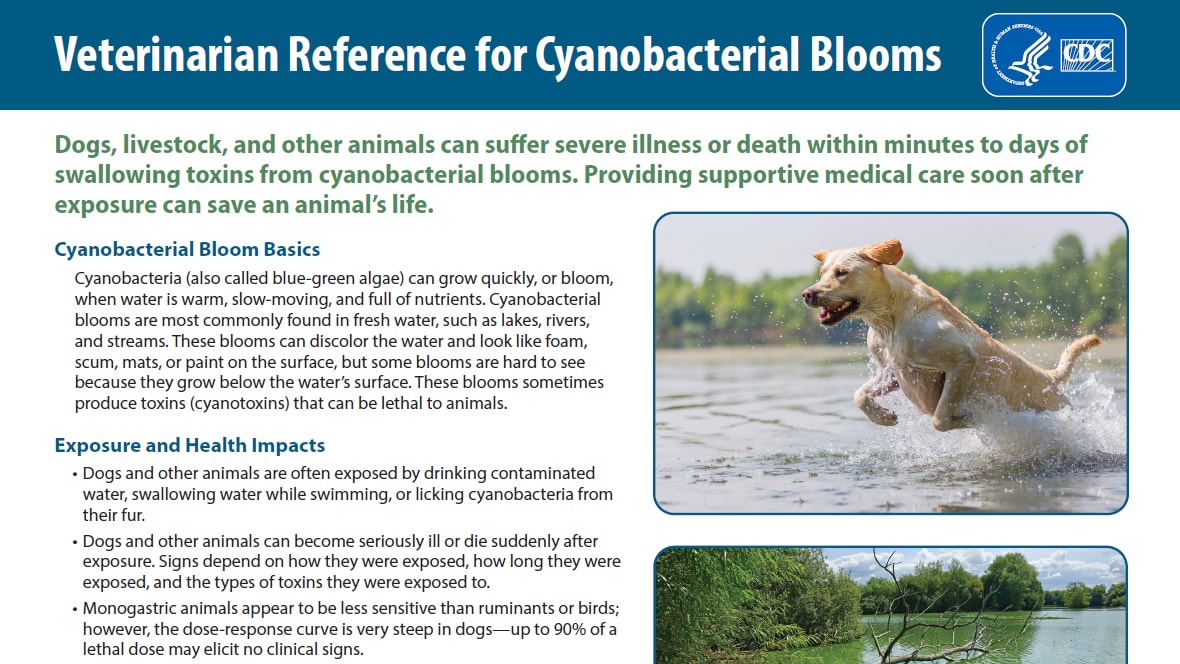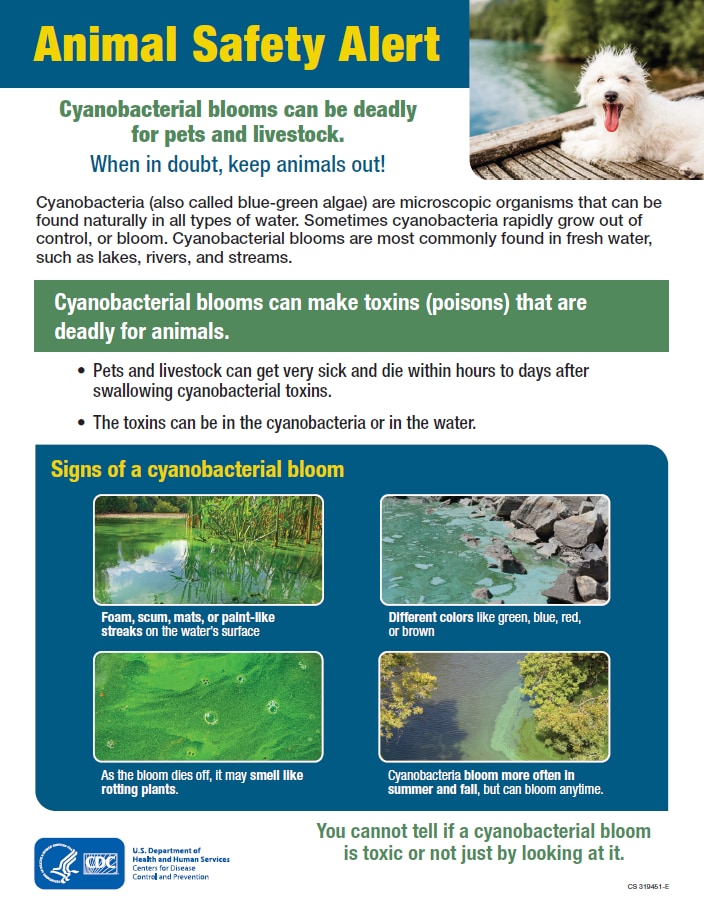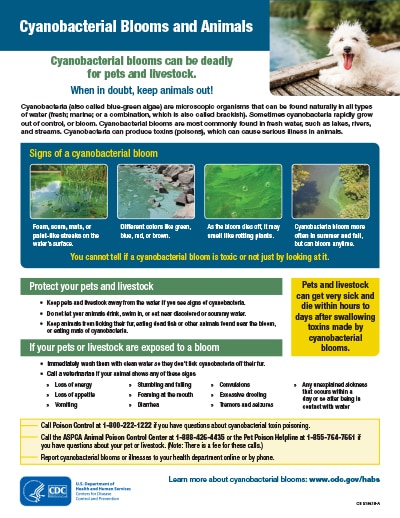Key points
- Harmful algal blooms are the rapid growth of algae or cyanobacteria in water that can harm people, animals, or the environment.
- Harmful algal blooms and their toxins can be deadly for animals, including dogs, livestock, and wildlife.
- Animals are exposed by drinking water, eating algae, or eating fish contaminated with algal toxins; skin or eye contact; or inhalation.
- Quickly providing supportive medical care can save animals' lives. There are no known antidotes to these toxins.
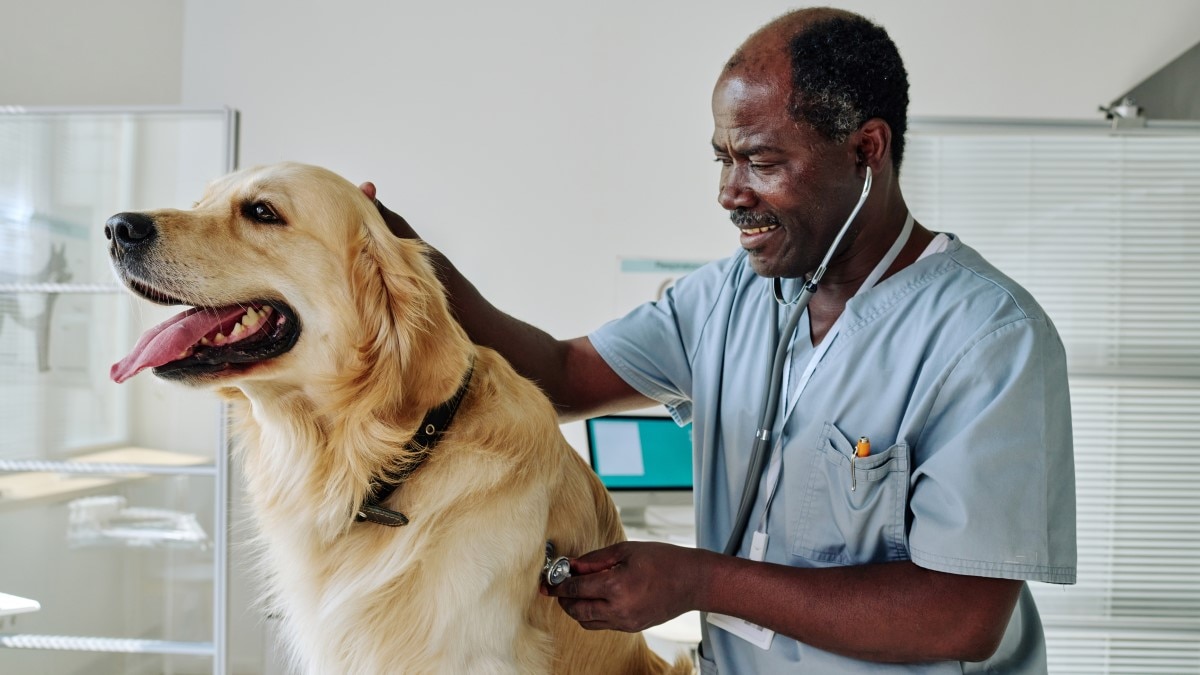
Background
Algae and cyanobacteria (also called blue-green algae) in water can quickly grow out of control, or "bloom." Some of these blooms produce toxins that cause illnesses in people and animals.
Harmful algal blooms can grow in fresh water, salt water, or brackish water (a mixture of fresh and salt water). They are more likely to grow when water is warm, slow-moving, and has high levels of nutrients. Harmful algal blooms occur across the United States and around the world.
Some harmful algal blooms discolor water or can be seen on the water's surface. Others grow below the water and are hard to see.
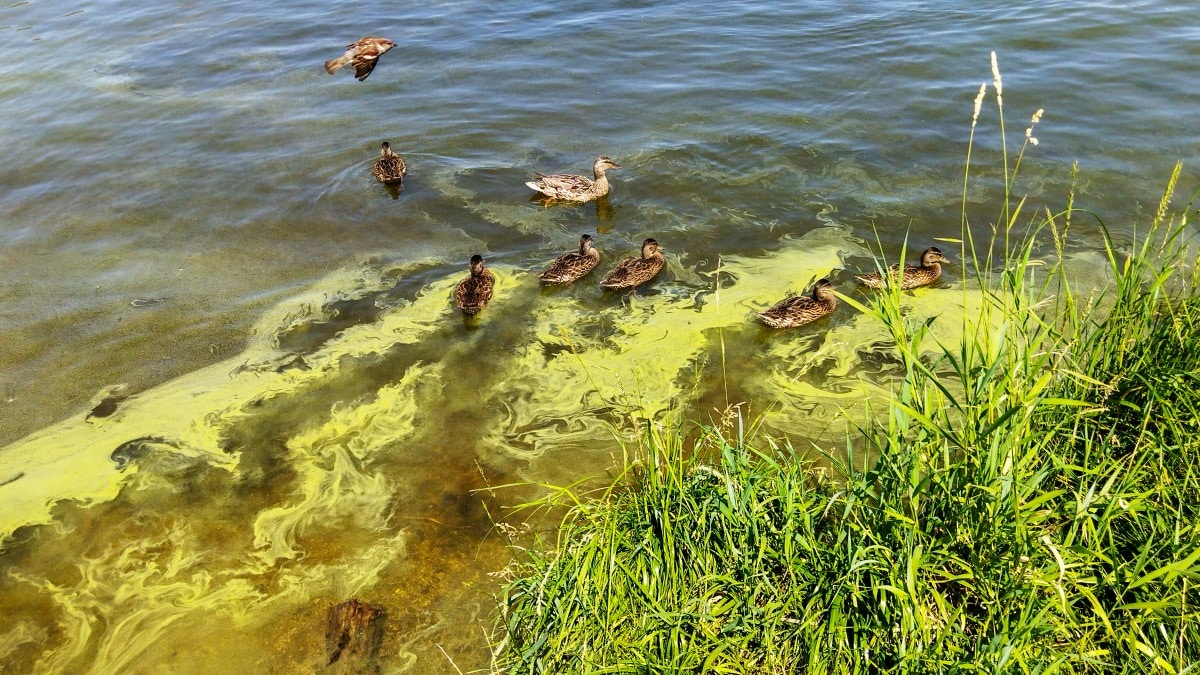
Causes
Many different types of algae can cause harmful algal blooms. However, three types —cyanobacteria, dinoflagellates, and diatoms—cause many of the blooms that make people and animals ill.
Cyanobacteria cause most harmful algal blooms in bodies of fresh water, like lakes or rivers. Less commonly, cyanobacteria can cause harmful algal blooms in salt or brackish water. Diatoms and dinoflagellates cause most harmful algal blooms in bodies of salt water or brackish water.
Cyanobacteria, diatoms, and dinoflagellates make various toxins that can cause illnesses.
Blooms of Sargassum seaweed may be an emerging animal health concern. Researchers are just beginning to understand human health impacts caused by Sargassum seaweed landfalls; reports of animal illnesses are so far limited.
Exposure risks
Animals can become ill from harmful algal blooms or their toxins through ingestion, skin or eye contact, or inhalation. Animals—including dogs, livestock, and wildlife—are often exposed by going in or near contaminated bodies of water.
Ingestion:
- Swallowing water contaminated with harmful algal blooms or their toxins
- Eating algae, fish, or shellfish contaminated with toxins
- Licking cyanobacteria or algae off their fur
- Swallowing blue-green algae dietary supplements contaminated with toxins
Inhalation: breathing in aerosolized toxins
Skin contact: direct skin contact with contaminated water
Eye contact: eye contact with contaminated water or aerosols
Exposure questions
Contact your local poison control center at 1-800-222-1222 with questions about exposures to harmful algal blooms.
You can also call the ASPCA Animal Poison Control Center at 1-888-426-4435 or the Pet Poison Helpline at 1-855-764-7661 for questions about animal health. Note that there is a fee for these calls.
Health effects
Animals can die quickly
Illnesses can be mild to life-threatening.
Signs of illness depend on:
- How an animal was exposed
- How long they were exposed
- The type or types of toxins they were exposed to
Freshwater harmful algal blooms
Signs of illness appear minutes to hours after an animal is exposed to a harmful algal bloom of cyanobacteria or its toxins.
Toxins made by cyanobacteria (cyanotoxins) have killed dogs, cattle, birds, fish, and other wildlife. Monogastric animals appear to be less sensitive than ruminants or birds to these toxins. However, the dose-response curve is very steep in dogs—up to 90% of a lethal dose may cause no clinical signs. The most frequently reported signs in dogs are gastrointestinal, such as vomiting or foaming at the mouth.
Hepatotoxins and nephrotoxins
Signs of illness can include:
- Excess drooling, vomiting, diarrhea, foaming at the mouth
- Jaundice, hepatomegaly
- Blood in urine or dark urine
- Malaise or lethargy
- Stumbling
- Loss of appetite
- Photosensitization in recovering animals
- Abdominal tenderness
- Liver injury, including hepatoenteritis or necrotic hepatic lesion
Neurotoxins
Signs of illness can include:
- Progression of muscle twitches
- Spastic twitching
- Stumbling
- Behavior changes
- Loss of coordination
- Ataxia
- Violent tremors
- Partial paralysis
- For saxitoxin, high doses may lead to respiratory paralysis and death if an animal does not receive artificial ventilation
Dermal toxins
Signs of illness can include:
- Rash
- Hives
- Allergic reaction
Saltwater harmful algal blooms
The first sign of a harmful algal bloom in a body of salt water may be dead fish and other animals along the shore. Dogs, fish, marine seabirds, and marine mammals (dolphins, sea lions, whales, and manatees) have died from exposure to these toxins.
Brevetoxins
Karenia brevis red tides in the Gulf of Mexico (a specific type of harmful algal bloom) can make brevetoxins. Karenia brevis red tides can kill large numbers of fish, shellfish, marine mammals (such as dolphins), and other animals that live in salt water. Brevetoxins can also damage manatees' lungs.
Domoic acid
A harmful algal bloom toxin called domoic acid can damage nervous systems in birds and marine mammals, including California sea lions. Exposure to domoic acid can cause them to have seizures or behave strangely.
Prevention
People can protect their pets and livestock from harmful algal blooms by keeping them from:
- Drinking, swimming, or grazing near water that looks or smells bad
- Eating algae or dead animals on the water's shore
If an animal goes in water that may have a harmful algal bloom, owners should rinse them off immediately after. They should use tap water from a sink, shower, hose, or outdoor spigot.
Testing and diagnosis
There are currently no clinically available diagnostic tests to detect harmful algal bloom toxins. Assessing exposure, ruling out similar illnesses, and using other available tests may help you diagnose patients.
Freshwater harmful algal blooms
The following differential diagnoses and findings may help you diagnose illnesses caused by cyanotoxins. You may also consider taking a chest radiograph if your patient has respiratory signs.
Hepatotoxins and nephrotoxins
Similar illnesses include:
- Acetaminophen or NSAID overdose
- Rodenticide ingestion
- Aflatoxicosis
- Other hepatotoxin poisonings
Possible laboratory or other findings:
- Elevated bile acids, ALP, AST, GGT
- Hyperkalemia
- Hypoglycemia
- Prolonged clotting time
- Proteinuria
- Glycosuria (in severe toxicity)
- Cyanotoxins detected in clinical specimens from an ill animal's stomach contents
Neurotoxins
Similar illnesses include:
- Pesticide poisoning
- Myasthenia gravis
- Other poisoning
Laboratory findings that support a diagnosis include detecting cyanotoxins in clinical specimens from an ill animal's stomach contents.
Dermal toxins
Other dermal allergens may cause similar signs of illness as those caused by dermal cyanotoxins.
Fur stained blue-green can be a sign that an animal was in water with a harmful algal bloom of cyanobacteria.
Saltwater harmful algal blooms
Some laboratories can test tissue samples and stomach contents of affected animals for marine algal toxins. The National Oceanic and Atmospheric Administration (NOAA) and Food and Drug Administration (FDA) have specialized laboratories that can do this testing.
Treatment
Providing supportive medical care to an animal soon after they are exposed to harmful algal bloom toxins can save its life. There are no know antidotes to these toxins, so care is sign-directed.
Freshwater harmful algal blooms
Provide supportive medical care if an animal has been exposed to cyanotoxins. There are currently no established treatments. However, the following treatments may be helpful:
- Activated charcoal may be useful within the first hour after exposure
- Atropine is effective for exposure to saxitoxins
- Cholestyramine might be helpful for dogs exposed to microcystins
Saltwater harmful algal blooms
Provide supportive treatment for animals exposed to toxins from harmful algal blooms in oceans or bays.
If available, you can use brevenal to treat marine mammals exposed to brevetoxins. Brevenal is a natural inhibitor of brevetoxin action in sodium channel receptor binding assays. Brevetoxins are often produced during Karenia brevis red tides, which are common in the Gulf of Mexico.
Reporting and data
Contact your local or state health department to report a harmful algal bloom-related health event. Health departments voluntarily report animal and human health events to CDC's tracking system, the One Health Harmful Algal Bloom System (OHHABS).
Find data
Resources
- Harmful Algal Blooms | AVMA
- Blue-Green Algae and Other Water Toxins and Treatments | ASPCApro
- Food Poisoning from Marine Toxins | CDC Yellow Book
- Cyanobacterial Blooms and Associated Illnesses: A Clinician Training Module for Physicians and Healthcare Providers | ASTHO
- Blue-Green Algae Products and Microcystins | FDA
- Distribution of Harmful Algal Blooms in the U.S. | Woods Hole Oceanographic Institution
Use CDC's resources below to learn more about animal impacts and talk to clients. To order free printed copies, visit CDC Publications On Demand. Choose "Harmful Algal Blooms" on the dropdown menu next to "Program."

